Related Research Articles
Numerous civilians, including men, women, children, government officials, activists, secular intellectuals and clerics have been victims of assassination, terrorism, or violence against non-combatants, over the course of modern Iranian history. Among the most notable acts of terrorism in Iran in the 20th century have been the 1978 Cinema Rex fire and the 1990s chain murders of Iran.

The Islamic State (IS), also known as the Islamic State of Iraq and Syria (ISIS), the Islamic State of Iraq and the Levant (ISIL), the Islamic State of Iraq and al-Sham (ISIS), and by its Arabic acronym Daesh is a transnational Salafi jihadist group and former unrecognized Quasi-state.

The Islamic State of Iraq was a Salafi jihadist militant organization that fought the forces of the U.S.-led coalition during the Iraqi insurgency. The organization aimed to overthrow the Iraqi federal government and establish an Islamic state governed by Sharia law in Iraq.
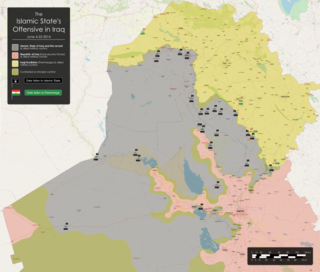
The Northern Iraq offensive began on 4 June 2014, when the Islamic State of Iraq and Levant, assisted by various insurgent groups in the region, began a major offensive from its territory in Syria into Iraq against Iraqi and Kurdish forces, following earlier clashes that had begun in December 2013 involving guerillas.
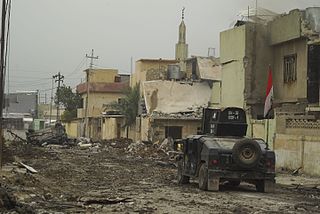
The War in Iraq (2013–2017) was an armed conflict between Iraq and its allies and the Islamic State. Following December 2013, the insurgency escalated into full-scale guerrilla warfare following clashes in the cities of Ramadi and Fallujah in parts of western Iraq, and culminated in the Islamic State offensive into Iraq in June 2014, which lead to the capture of the cities of Mosul, Tikrit and other cities in western and northern Iraq by the Islamic State. Between 4–9 June 2014, the city of Mosul was attacked and later fell; following this, Prime Minister Nouri al-Maliki called for a national state of emergency on 10 June. However, despite the security crisis, Iraq's parliament did not allow Maliki to declare a state of emergency; many legislators boycotted the session because they opposed expanding the prime minister's powers. Ali Ghaidan, a former military commander in Mosul, accused al-Maliki of being the one who issued the order to withdraw from the city of Mosul. At its height, ISIL held 56,000 square kilometers of Iraqi territory, containing 4.5 million citizens.

The departure of US troops from Iraq in 2011 ended the period of occupation that had begun with the U.S.-led invasion in March 2003. The time since U.S. withdrawal has been marked by a renewed Iraqi insurgency and by a spillover of the Syrian civil war into Iraq. By 2013, the insurgency escalated into a renewed war, the central government of Iraq being opposed by ISIL and various factions, primarily radical Sunni forces during the early phase of the conflict. The war ended in 2017 with an Iraqi government and allied victory, however ISIL continues a low-intensity insurgency in remote parts of the country.
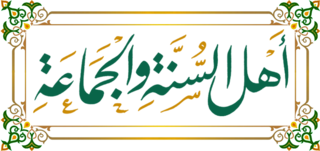
Anti-Sunnism is hatred of, prejudice against, discrimination against, persecution of, and violence against Sunni Muslims. It has also been described as "Anti-Sunni sentiment" "Sunniphobia", the "fear or hatred of Sunnism and Sunnites".

The Iranian intervention in Iraq has its roots in the post-2003 invasion of Iraq by the United States and its allies, when the infrastructure of the Iraqi armed forces, as well as intelligence, were disbanded in a process called "de-Ba'athification" which allowed militias with close ties to Tehran to join the newly reconstituted army.

The Second Battle of Tikrit was a battle in which Iraqi Security Forces recaptured the city of Tikrit from the Islamic State of Iraq and the Levant (ISIL). Iraqi forces consisted of the Iraqi Army and the Popular Mobilization Forces, receiving assistance from Iran's Quds Force officers on the ground, and air support from the American, British, and French air forces.

The Battle of Sarrin refers to a military operation during 2015 in the northeastern Aleppo Governorate, during the Syrian Civil War, conducted by Kurdish YPG and allied forces against the Islamic State of Iraq and the Levant in the town of Sarrin, in an effort to capture the town and the surrounding region.
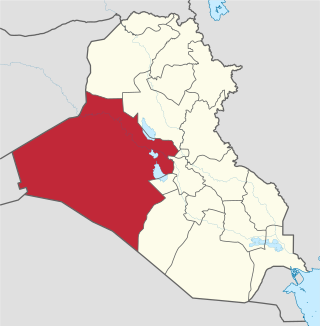
The Al-Karmah offensive, codenamed Fajr al-Karma, was an offensive launched by the Iraqi Army and anti-ISIL Sunni tribal fighters to recapture the Al-Karmah district taken by the Islamic State of Iraq and the Levant in Iraq. The offensive began on 14 April 2015. During the offensive the anti-ISIL forces captured part of the city of Al-Karmah, and the old road of Al-Karmah.

The Timeline of the War in Iraq covers the War in Iraq, a war which erupted that lasted in Iraq from 2013 to 2017, during the first year of armed conflict.

The Islamic State – Khorasan Province is a regional branch of the Salafi jihadist group Islamic State (IS) active in South-Central Asia, primarily Afghanistan and Pakistan. ISIS–K seeks to destabilize and replace current governments within the historic Khorasan region with the goal of establishing a caliphate across South and Central Asia, governed under a strict interpretation of Islamic sharia law, which they plan to expand beyond the region.
In early 2014, the jihadist group Islamic State of Iraq and the Levant captured extensive territory in Western Iraq in the Anbar campaign, while counter-offensives against it were mounted in Syria. Raqqa in Syria became its headquarters. The Wall Street Journal estimated that eight million people lived under its control in the two countries.
This article contains a timeline of events from January 2015 to December 2015 related to the Islamic State of Iraq and the Levant (ISIL/ISIS). This article contains information about events committed by or on behalf of the Islamic State, as well as events performed by groups who oppose them.

The Followers of Zainab Brigade, also known as the Zainebiyoun Brigade or Zainebiyoun Division, is a Pakistani Shia Khomeinist militant group actively engaged in the Syrian Civil War. It draws recruits mainly from Shia Pakistanis living in Iran, with some also Shia Muslim communities living in various regions of Pakistan.
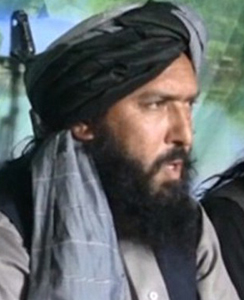
Hafiz Saeed Khan, also known as Mullah Saeed Orakzai, Shaykh Hafidh Sa'id Khan, or Maulvi Saeed Khan, was an Islamic militant and emir for the militant group Islamic State – Khorasan Province (ISIS–K) from January 2015 until his death in July 2016. Prior to 2015, Khan fought alongside the Afghan Taliban against NATO forces in Afghanistan, joined the militant group Tehrik-e Taliban Pakistan (TTP) as a senior commander, and later swore allegiance to ISIS caliph Abu Bakr al-Baghdadi, established ISIS–K in Afghanistan as the province's first emir until his death in a reported American drone strike.

The 2017 Tehran attacks were a series of two simultaneous terrorist attacks that occurred on 7 June 2017 that were carried out by five terrorists belonging to the Islamic State of Iraq and the Levant (ISIL) against the Iranian Parliament building and the Mausoleum of Ruhollah Khomeini, both in Tehran, Iran, leaving 17 civilians dead and 43 wounded. The shootings were the first terrorist attacks in Tehran in more than a decade, and the first major terror attack in the country since the 2010 Zahedan bombings.
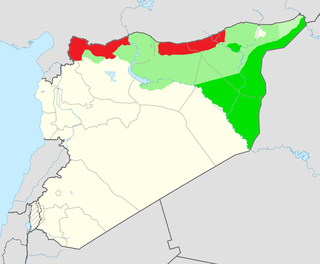
The Eastern Syria insurgency is an armed insurgency being waged by remnants of the Islamic State of Iraq and the Levant (ISIL) and both pro and anti-Syrian government Arab nationalist insurgents, against the Autonomous Administration of North and East Syria (AANES), its military, and their allies in the US-led Combined Joint Task Force – Operation Inherent Resolve (CJTF–OIR) coalition.
The origins of the Islamic State group can be traced back to three main organizations. Earliest of these was the "Jamāʻat al-Tawḥīd wa-al-Jihād" organization, founded by the Jihadist leader Abu Mus'ab al-Zarqawi in Jordan in 1999. The other two predecessor organizations emerged during the Iraqi insurgency against the U.S. occupation forces. These included the "Jaish al-Ta'ifa al-Mansurah" group founded by Abu Omar al-Baghdadi in 2004 and the "Jaysh Ahl al-Sunnah wa’l-Jama’ah" group founded by Abu Bakr al-Baghdadi and his associates in the same year.
References
- ↑ Bazzi, Mohamad (4 January 2015). "Iran will do what it takes to fight ISIS". CNN . Retrieved 21 April 2015.
- ↑ Gomes Guimarães, Bruno; Scalabrin Müller, Marcelo (9 December 2014). "Iran Joins ISIS Fight". The Diplomat . Retrieved 21 April 2015.
- ↑ Farnaz Fassihi (13 June 2014). "Iran Deploys Forces to Fight Militants in Iraq". Wall Street Journal .
- ↑ Martin Chulov (14 June 2014). "Iran sends troops into Iraq to aid fight against Isis militants". The Guardian .
- ↑ "'Iran first to help Iraq against ISIL'". Al-Alam . 26 September 2014. Retrieved 21 April 2015.
- ↑ "Could Iran's elite military force defeat ISIL?". Al Jazeera . 18 March 2015. Retrieved 21 April 2015.
- ↑ Bozorgmehr, Najmeh (7 November 2014). "Iranian general is new hero in battle against Isis". Financial Times . Retrieved 21 April 2015.
- ↑ Moore, Jack (5 March 2015). "Iranian Military Mastermind Leading Battle to Recapture Tikrit From ISIS". Newsweek . Retrieved 21 April 2015.
- ↑ "انهدام 2 تیم تروریستی وابسته به داعش توسط نزاجا در مرزهای غربی کشور- اخبار سیاسی - اخبار تسنیم - Tasnim".
- ↑ Zarif, Mohammad Javad (20 April 2015). "Mohammad Javad Zarif: A Message From Iran". The New York Times . Retrieved 21 April 2015.
- ↑ "Supreme Leader's Speech in Meeting with People of East Azerbaijan". The Center for Preserving and Publishing the Works of Grand Ayatollah Sayyid Ali Khamenei. 18 February 2015. Archived from the original on 22 February 2015. Retrieved 21 April 2015.
- ↑ "Report says ISIL terrorist group has a base near US". Iran Daily . 16 April 2015. Retrieved 21 April 2015.
- ↑ "Larijani Reminds Regional States of Iran's Sacrifices against ISIL Terrorists". Fars News Agency . 12 March 2015. Archived from the original on 28 March 2015. Retrieved 21 April 2015.
- 1 2 "Iran Says Arrests ISIL Suspects at Border". Tasnim News Agency . 8 September 2014. Retrieved 21 April 2015.
- ↑ "Iranian Official: US Not Serious about Countering ISIL Terrorists - Politics news".
- ↑ Smyth, Gareth (18 November 2014). "Iran fears Isis militants are part of wider Sunni backlash". Tehran Bureau . Retrieved 21 April 2015.
- ↑ Esfandiari, Golnaz (4 July 2014). "Explainer: How Iran Could Help Iraq Fight ISIL". RFE/RL . Retrieved 21 April 2015.
- 1 2 "ISIL Designated Emir for Iran Arrested". Iranian Diplomacy. 21 September 2014. Retrieved 21 April 2015.
- ↑ Sajid, Islamuddin (19 January 2015). "Hafiz Saeed Khan: The former Taliban warlord taking Isis to India and Pakistan". International Business Times . Retrieved 21 April 2015.
- ↑ "'First IS attack' in Iran kills 12". BBC News. June 7, 2017.
- ↑ Behravesh, Maysam. "ISIL attack in Iran: Why now and what will happen next?". www.aljazeera.com.
- ↑ Kourdi, Eyad. "ISIL attack in Kerman Iran". www.cnn.com.
- ↑ "Many Iranians want military to intervene against Isis". Tehran Bureau . 27 June 2014. Retrieved 21 April 2015.
- ↑ Adow, Mohammed (17 January 2015). "Iranian Kurds join the fight against ISIL". Al Jazeera . Retrieved 21 April 2015.
- ↑ Haqiqi, Fuad (11 December 2014). "ISIS boasts rising number of recruits among Iranian Kurds". Rudaw. Retrieved 15 April 2015.